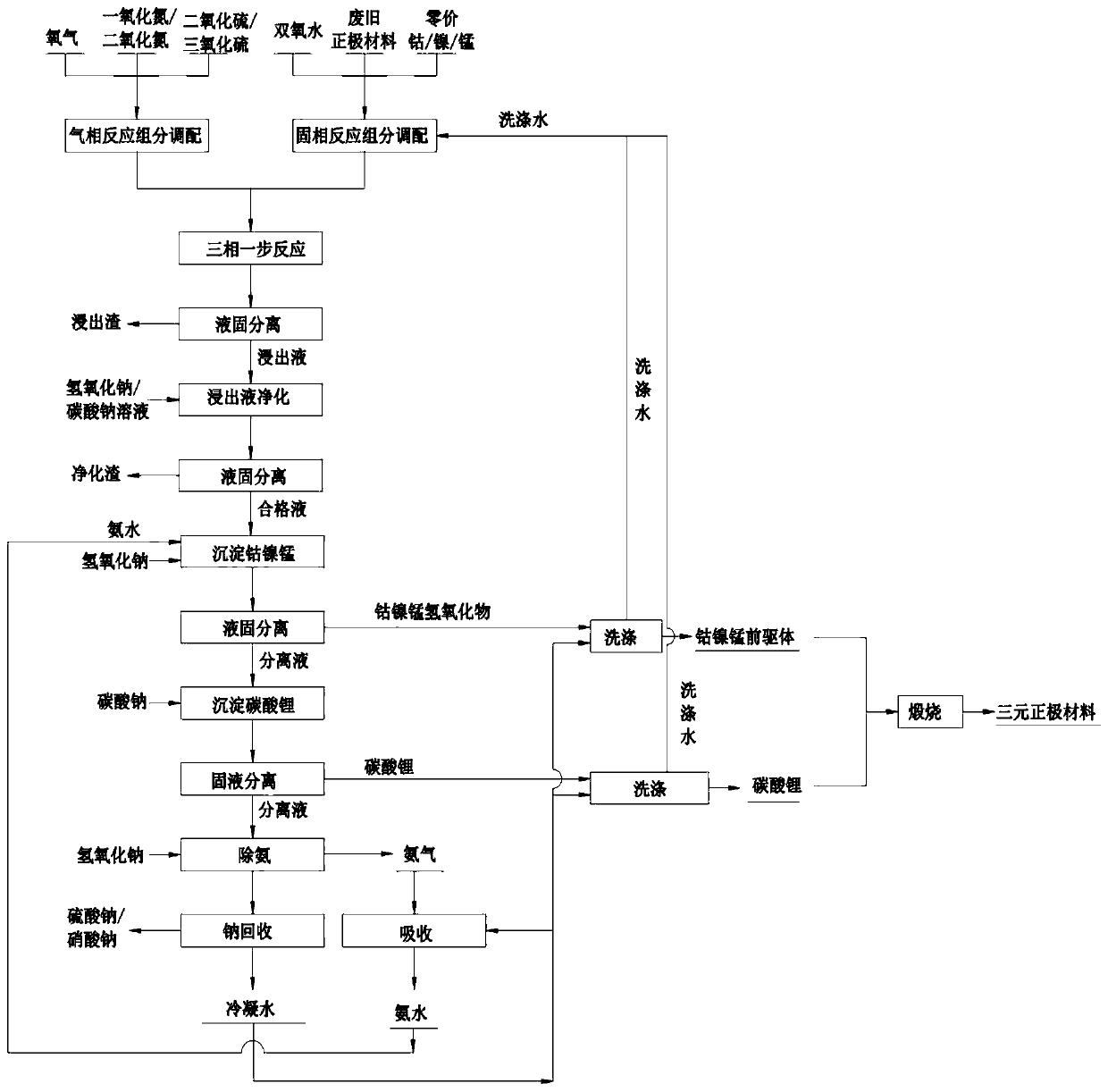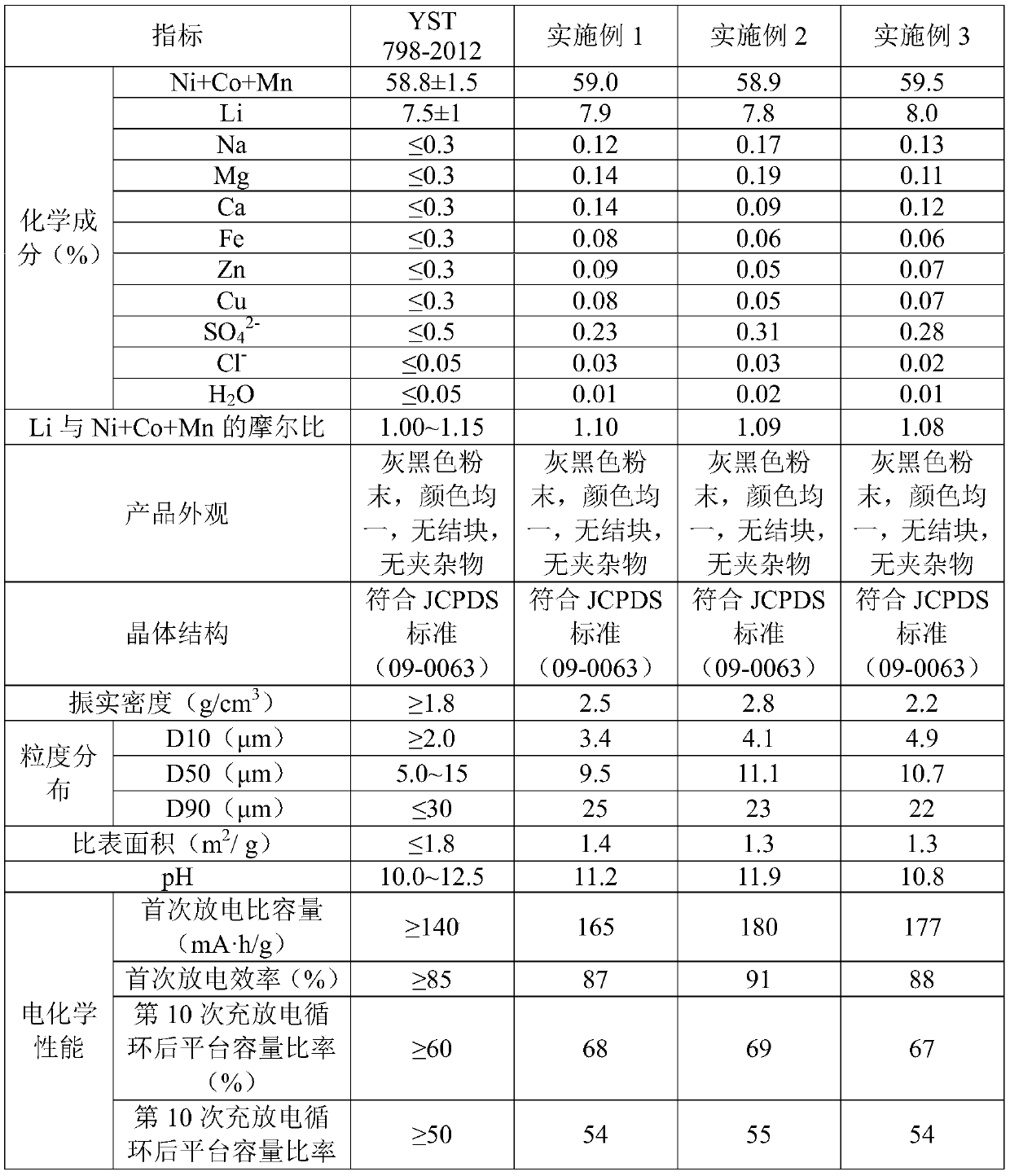A method for resource utilization of lithium battery waste positive electrode materials
A cathode material and lithium battery technology, applied in the field of resource utilization of waste cathode materials of lithium batteries, can solve the problems of low process efficiency and difficult impurity removal, and achieve the effects of high solution quality, easy impurity removal and purification, and beneficial to efficient recovery.
- Summary
- Abstract
- Description
- Claims
- Application Information
AI Technical Summary
Problems solved by technology
Method used
Image
Examples
Embodiment 1
[0063] A method for resource utilization of lithium battery waste positive electrode materials, comprising the following steps:
[0064] (1) Preparation of liquid-solid reaction components: Mix 10 kg of waste positive electrode material powder that has been crushed and passed through an 80-mesh sieve with 1 kg of cobalt powder to obtain 11 kg of solid components; mix the obtained solid phase components with 25 L of steam condensed water to make slurry , and after stirring evenly, add 500mL concentration of 30% hydrogen peroxide to obtain liquid-solid reaction components that meet the requirements;
[0065] (2) The deployment of gas phase reaction components: mix sulfur dioxide, sulfur trioxide, nitrogen monoxide, nitrogen dioxide and oxygen according to the volume ratio of 1:0.5:1:1.5:2.4 to obtain sulfur dioxide, trioxide and Gas-phase reactive components of sulfur oxides, nitrogen monoxide, nitrogen dioxide and oxygen mixtures;
[0066] (3) Three-phase one-step reaction: th...
Embodiment 2
[0075] A method for resource utilization of lithium battery waste positive electrode materials, comprising the following steps:
[0076] (1) Preparation of liquid-solid reaction components: Mix 10kg of waste positive electrode material powder that has been crushed and passed through a 100-mesh sieve with 0.8kg of manganese powder and 0.2kg of cobalt powder to obtain 11kg of solid components; mix the resulting solid phase components with 50L Mix steam condensed water to make pulp, and after stirring evenly, add 450mL of hydrogen peroxide with a concentration of 28% to obtain liquid-solid reaction components that meet the requirements;
[0077] (2) The deployment of gas phase reaction components: the waste gas containing 10% sulfur dioxide concentration, 1% nitrogen monoxide concentration and 10% oxygen concentration is passed into the catalytic reactor to convert part of sulfur dioxide and nitrogen monoxide into three Sulfur and nitrogen dioxide are oxidized to obtain a mixed g...
Embodiment 3
[0087] A method for resource utilization of lithium battery waste positive electrode materials, comprising the following steps:
[0088] (1) Preparation of liquid-solid reaction components: mix 20kg of waste positive electrode material powders that have been crushed and passed through a 120 mesh sieve with 0.5kg of cobalt powder, 0.5kg of manganese powder and 0.5kg of nickel powder to obtain 21.5kg of solid components; Mix the solid phase components with 50L of steam condensed water to make slurry, and after stirring evenly, add 600mL of 28% hydrogen peroxide to obtain the liquid-solid reaction components that meet the requirements;
[0089] (2) The deployment of gas phase reaction components: adding 1% sulfur trioxide gas to waste gas containing 10% sulfur dioxide concentration, 0.9% nitrogen monoxide concentration, 0.1% nitrogen dioxide concentration and 10% oxygen concentration, Obtain the mixed gas of sulfur dioxide, sulfur trioxide, nitrogen monoxide, nitrogen dioxide and...
PUM
| Property | Measurement | Unit |
|---|---|---|
| particle size (mesh) | aaaaa | aaaaa |
Abstract
Description
Claims
Application Information
 Login to View More
Login to View More - Generate Ideas
- Intellectual Property
- Life Sciences
- Materials
- Tech Scout
- Unparalleled Data Quality
- Higher Quality Content
- 60% Fewer Hallucinations
Browse by: Latest US Patents, China's latest patents, Technical Efficacy Thesaurus, Application Domain, Technology Topic, Popular Technical Reports.
© 2025 PatSnap. All rights reserved.Legal|Privacy policy|Modern Slavery Act Transparency Statement|Sitemap|About US| Contact US: help@patsnap.com



